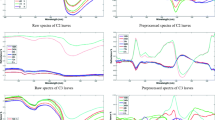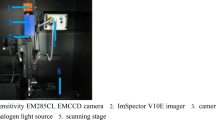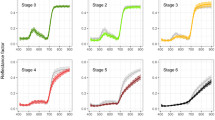Abstract
Spikelet diseases pose severe threats to crop production and crop protection requires timely evaluation of disease severity (DS). However, most studies have only investigated the spikelet diseases within a short period of crop growth. Few have examined the consistency in DS monitoring accuracy across growth stages. This study aimed to investigate the differences in spectral responses among growth stages and to develop a spectral index (SI), rice spikelet rot index (RSRI), for multi-stage monitoring of the rice spikelet rot disease. Proximal hyperspectral images were collected over spikelets with various levels of DS at heading, anthesis, and grain filling stages. The reflectance was related to the DS extracted from concurrent high-resolution RGB images. The proposed RSRI was evaluated for the DS estimation and lesion mapping across growth stages in comparison with existing SIs. The results demonstrated that the spectral responses to DS in the green and near-infrared regions for filling were weaker than those for anthesis, and blue bands were necessary in DS quantification for early infection. The RSRI-based models exhibited the best validation accuracy for heading and the most consistent performance across growth stages as comparison to other SIs (Heading: R2 = 0.65; anthesis: R2 = 0.84; filling: R2 = 0.78). Moreover, RSRI-based DS maps exhibited the best lesion identification for slightly, mildly, and severely infected spikelets. This study suggests that RSRI could be promising in breeding and crop protection as a novel index for DS estimation regardless of the spikelet ripening effect.













Similar content being viewed by others
Abbreviations
- DS:
-
Disease severity
- RSRD:
-
Rice spikelet rot disease
- HSI:
-
Hyperspectral image
- VNIR:
-
Visible and near-infrared
- NIR:
-
Near-infrared
- DD:
-
Double difference
- SI:
-
Spectral index
- RSRI:
-
Rice spikelet rot index
References
Brugger, A., Behmann, J., Paulus, S., Luigs, H. G., Kuska, M. T., Schramowski, P., et al. (2019). Extending hyperspectral imaging for plant phenotyping to the UV-range. Remote Sensing, 11(12), 1401. https://doi.org/10.3390/rs11121401.
Brugger, A., Schramowski, P., Paulus, S., Steiner, U., Kersting, K., & Mahlein, A. (2021). Spectral signatures in the UV range can be combined with secondary plant metabolites by deep learning to characterize barley–powdery mildew interaction. Plant Pathology, 70(7), 1572–1582. https://doi.org/10.1111/ppa.13411.
Chen, W., Zhou, Q., & Huang, J. F. (2006). Estimating pigment contents in leaves and panicles of rice after milky ripening by hyperspectral vegetation indices. Chineses Journal of Rice Science, 20(4), 434. https://doi.org/10.16819/j.1001-7216.2006.04.017
Cheng, T., Zhu, Y., Li, D., Yao, X., & Zhou, K. (2018). Hyperspectral remote sensing of leaf nitrogen concentration in cereal crops. In P. S. Thenkabail, J. G. Lyon, & A. Huete (Eds.), Hyperspectral indices and image classifications for agriculture and vegetation (2nd ed., pp. 163–182). CRC Press. https://doi.org/10.1201/9781315159331-6
Feng, Z. H., Wang, L. Y., Yang, Z. Q., Zhang, Y. Y., Li, X., Song, L., et al. (2022). Hyperspectral monitoring of Powdery Mildew Disease Severity in Wheat based on machine learning. Frontiers in Plant Science, 13, 828454. https://doi.org/10.3389/fpls.2022.828454.
Feret, J. B., François, C., Asner, G. P., Gitelson, A. A., Martin, R. E., Bidel, L. P. R., et al. (2008). PROSPECT-4 and 5: Advances in the leaf optical properties model separating photosynthetic pigments. Remote Sensing of Environment, 112(6), 3030–3043. https://doi.org/10.1016/j.rse.2008.02.012
Gamon, J. A., Huemmrich, K. F., Wong, C. Y. S., Ensminger, I., Garrity, S., Hollinger, D. Y., et al. (2016). A remotely sensed pigment index reveals photosynthetic phenology in evergreen conifers. Proceedings of the National Academy of Sciences, 113(46), 13087–13092. https://doi.org/10.1073/pnas.1606162113
Gamon, J. A., Peñuelas, J., & Field, C. B. (1992). A narrow-waveband spectral index that tracks diurnal changes in photosynthetic efficiency. Remote Sensing of Environment, 41(1), 35–44. https://doi.org/10.1016/0034-4257(92)90059-S.
Gao, Z., Zhao, Y., Khot, L. R., Hoheisel, G. A., & Zhang, Q. (2019). Optical sensing for early spring freeze related blueberry bud damage detection: Hyperspectral imaging for salient spectral wavelengths identification. Computers and Electronics in Agriculture, 167, 105025. https://doi.org/10.1016/j.compag.2019.105025
Gold, K. M., Townsend, P. A., Chlus, A., Herrmann, I., Couture, J. J., Larson, E. R., & Gevens, A. J. (2020). Hyperspectral measurements enable pre-symptomatic detection and differentiation of contrasting physiological effects of late blight and early blight in Potato. Remote Sensing, 12(2), 286. https://doi.org/10.3390/rs12020286
Gonzalez, R. C., & Woods, R. E. (2002). Digital image processing (2nd ed.). Prentice Hall. Retrieved 20 June, 2021, from https://book.douban.com/subject/1868037/.
Gu, C., Wang, D., Zhang, H., Zhang, J., Zhang, D., & Liang, D. (2021). Fusion of Deep Convolution and shallow features to recognize the severity of wheat Fusarium Head Blight. Frontiers in Plant Science, 11, 599886. https://doi.org/10.3389/fpls.2020.599886.
He, L., Qi, S. L., Duan, J. Z., Guo, T. C., Feng, W., & He, D. X. (2021). Monitoring of wheat powdery mildew disease severity using multiangle hyperspectral remote sensing. IEEE Transactions on Geoscience and Remote Sensing, 59(2), 979–990. https://doi.org/10.1109/TGRS.2020.3000992.
Hornero, A., Hernández-Clemente, R., North, P. R. J., Beck, P. S. A., Boscia, D., Navas-Cortes, J. A., & Zarco-Tejada, P. J. (2020). Monitoring the incidence of Xylella fastidiosa infection in olive orchards using ground-based evaluations, airborne imaging spectroscopy and Sentinel-2 time series through 3-D radiative transfer modelling. Remote Sensing of Environment, 236, 111480. https://doi.org/10.1016/j.rse.2019.111480.
Huang, S., Qi, L., Ma, X., Xue, K., Wang, W., & Zhu, X. (2015). Hyperspectral image analysis based on BoSW model for rice panicle blast grading. Computers and Electronics in Agriculture, 118, 167–178. https://doi.org/10.1016/j.compag.2015.08.031.
Huang, S. W., Wang, L., Liu, L. M., Tang, S. Q., Zhu, D. F., & Savary, S. (2011a). Rice spikelet rot disease in China—1. Characterization of fungi associated with the disease. Crop Protection, 30(1), 1–9. https://doi.org/10.1016/j.cropro.2010.07.010.
Huang, S. W., Wang, L., Liu, L. M., Tang, S. Q., Zhu, D. F., & Savary, S. (2011b). Rice spikelet rot disease in China—2. Pathogenicity tests, assessment of the importance of the disease, and preliminary evaluation of control options. Crop Protection, 30(1), 10–17. https://doi.org/10.1016/j.cropro.2010.06.008.
Huo, L., Persson, H. J., & Lindberg, E. (2021). Early detection of forest stress from European spruce bark beetle attack, and a new vegetation index: Normalized distance red & SWIR (NDRS). Remote Sensing of Environment, 255, 112240. https://doi.org/10.1016/j.rse.2020.112240.
Jagadish, S. V. K., Murty, M. V. R., & Quick, W. P. (2015). Rice responses to rising temperatures—challenges, perspectives and future directions. Plant Cell & Environment, 38(9), 1686–1698. https://doi.org/10.1111/pce.12430.
Kobayashi, T., Sasahara, M., Kanda, E., Ishiguro, K., Hase, S., & Torigoe, Y. (2016). Assessment of rice panicle blast disease using airborne hyperspectral imagery. The Open Agriculture Journal, 10(1), 28–34. https://doi.org/10.2174/1874331501610010028.
Kochubey, S. M., & Kazantsev, T. A. (2012). Derivative vegetation indices as a new approach in remote sensing of vegetation. Frontiers of Earth Science, 6(2), 188–195. https://doi.org/10.1007/s11707-012-0325-z.
Kuska, M., Wahabzada, M., Leucker, M., Dehne, H. W., Kersting, K., Oerke, E. C., et al. (2015). Hyperspectral phenotyping on the microscopic scale: Towards automated characterization of plant-pathogen interactions. Plant Methods, 11(1), 28. https://doi.org/10.1186/s13007-015-0073-7.
Lassalle, G. (2021). Monitoring natural and anthropogenic plant stressors by hyperspectral remote sensing: Recommendations and guidelines based on a meta-review. Science of the Total Environment, 788, 147758. https://doi.org/10.1016/j.scitotenv.2021.147758.
Lei, S., Wang, L., Liu, L., Hou, Y., Xu, Y., Liang, M., et al. (2019). Infection and colonization of pathogenic Fungus Fusarium proliferatum in rice spikelet rot disease. Rice Science, 26(1), 60–68. https://doi.org/10.1016/j.rsci.2018.08.005.
Li, D., Chen, J. M., Zhang, X., Yan, Y., Zhu, J., Zheng, H., et al. (2020). Improved estimation of leaf chlorophyll content of row crops from canopy reflectance spectra through minimizing canopy structural effects and optimizing off-noon observation time. Remote Sensing of Environment, 248, 111985. https://doi.org/10.1016/j.rse.2020.111985.
Li, D., Tian, L., Wan, Z., Jia, M., Yao, X., Tian, Y., et al. (2019). Assessment of unified models for estimating leaf chlorophyll content across directional-hemispherical reflectance and bidirectional reflectance spectra. Remote Sensing of Environment, 231, 111240. https://doi.org/10.1016/j.rse.2019.111240.
Liu, W., Liu, J., Triplett, L., Leach, J. E., & Wang, G. L. (2014). Novel insights into rice innate immunity against bacterial and fungal pathogens. In N. K. VanAlfen (Ed.), Annual review of phytopathology, (Vol. 52, pp. 213–241). Annual Reviews. https://doi.org/10.1146/annurev-phyto-102313-045926
Lucas, D., da Silva, A., Alves Filho, E. G., Silva, L. M. A., Huertas Tavares, C., Gervasio Pereira, O., de Campos, M., T., & da Silva, M., L (2021). Near infrared spectroscopy to rapid assess the rubber tree clone and the influence of maturation and disease at the leaves. Microchemical Journal, 168, 106478. https://doi.org/10.1016/j.microc.2021.106478.
Mackon, E., Mackon, J. D. E., Ma, G. C., Haneef Kashif, Y., Ali, M., Usman, N., B., & Liu, P. (2021). Recent insights into anthocyanin pigmentation, synthesis, trafficking, and regulatory mechanisms in rice (Oryza sativa L.) Caryopsis. Biomolecules, 11(3), 394. https://doi.org/10.3390/biom11030394.
Mahlein, A. K. (2016). Plant disease detection by imaging sensors—parallels and specific demands for precision agriculture and plant phenotyping. Plant Disease, 100(2), 241–251. https://doi.org/10.1094/PDIS-03-15-0340-FE.
Mahlein, A. K., Alisaac, E., Al Masri, A., Behmann, J., Dehne, H. W., & Oerke, E. C. (2019a). Comparison and combination of thermal, fluorescence, and hyperspectral imaging for monitoring fusarium head blight of wheat on spikelet scale. Sensors, 19(10), 2281. https://doi.org/10.3390/s19102281.
Mahlein, A. K., Kuska, M. T., Thomas, S., Wahabzada, M., Behmann, J., Rascher, U., & Kersting, K. (2019b). Quantitative and qualitative phenotyping of disease resistance of crops by hyperspectral sensors: Seamless interlocking of phytopathology, sensors, and machine learning is needed!. Current Opinion in Plant Biology, 50, 156–162. https://doi.org/10.1016/j.pbi.2019b.06.007.
Mahlein, A.-K., Rumpf, T., Welke, P., Dehne, H.-W., Plümer, L., Steiner, U., & Oerke, E.-C. (2013). Development of spectral indices for detecting and identifying plant diseases. Remote Sensing of Environment, 128, 21–30. https://doi.org/10.1016/j.rse.2012.09.019
Meng, R., Gao, R., Zhao, F., Huang, C., Sun, R., Lv, Z., & Huang, Z. (2022). Landsat-based monitoring of southern pine beetle infestation severity and severity change in a temperate mixed forest. Remote Sensing of Environment, 269, 112847. https://doi.org/10.1016/j.rse.2021.112847.
Merzlyak, M. N., Gitelson, A. A., Chivkunova, O. B., & Rakitin, V. Y. (1999). Non-destructive optical detection of pigment changes during leaf senescence and fruit ripening. Physiologia Plantarum, 106(1), 135–141. https://doi.org/10.1034/j.1399-3054.1999.106119.x.
Morel, J., Jay, S., Féret, J. B., Bakache, A., Bendoula, R., Carreel, F., & Gorretta, N. (2018). Exploring the potential of PROCOSINE and close-range hyperspectral imaging to study the effects of fungal diseases on leaf physiology. Scientific Reports, 8(1), 15933. https://doi.org/10.1038/s41598-018-34429-0.
Oberti, R., Marchi, M., Tirelli, P., Calcante, A., Iriti, M., & Borghese, A. N. (2014). Automatic detection of powdery mildew on grapevine leaves by image analysis: Optimal view-angle range to increase the sensitivity. Computers and Electronics in Agriculture, 104, 1–8. https://doi.org/10.1016/j.compag.2014.03.001.
Oerke, E. C. (2020). Remote sensing of diseases. Annual Review of Phytopathology, 58(1), 225–252. https://doi.org/10.1146/annurev-phyto-010820-012832.
Peñuelas, J., Filella, I., Lloret, P., Mun¯Oz, F., & Vilajeliu, M. (1995). Reflectance assessment of mite effects on apple trees. International Journal of Remote Sensing, 16(14), 2727–2733. https://doi.org/10.1080/01431169508954588.
Peñuelas, J., Gamon, J. A., Griffin, K. L., & Field, C. B. (1993). Assessing community type, plant biomass, pigment composition, and photosynthetic efficiency of aquatic vegetation from spectral reflectance. Remote Sensing of Environment, 46(2), 110–118. https://doi.org/10.1016/0034-4257(93)90088-F.
Poblete, T., Camino, C., Beck, P. S. A., Hornero, A., Kattenborn, T., Saponari, M., et al. (2020). Detection of Xylella fastidiosa infection symptoms with airborne multispectral and thermal imagery: Assessing bandset reduction performance from hyperspectral analysis. ISPRS Journal of Photogrammetry and Remote Sensing, 162, 27–40. https://doi.org/10.1016/j.isprsjprs.2020.02.010.
Ren, Y., Huang, W., Ye, H., Zhou, X., Ma, H., Dong, Y., et al. (2021). Quantitative identification of yellow rust in winter wheat with a new spectral index: Development and validation using simulated and experimental data. International Journal of Applied Earth Observation and Geoinformation, 102, 102384. https://doi.org/10.1016/j.jag.2021.102384.
Rouse, J. W., Haas, R. H., Deering, D. W., Schell, J. A., Harlan, J. C., Haas, R. H., et al. (1974). Monitoring the vernal advancement and retrogradation (Green Wave Effect) of natural vegetation. Retrieved June 3, 2022, from https://ntrs.nasa.gov/citations/19750020419.
Ruan, C., Dong, Y., Huang, W., Huang, L., Ye, H., Ma, H., et al. (2021). Prediction of wheat stripe rust occurrence with Time Series Sentinel-2 images. Agriculture, 11(11), 1079. https://doi.org/10.3390/agriculture11111079.
Singh, A., Jones, S., Ganapathysubramanian, B., Sarkar, S., Mueller, D., Sandhu, K., & Nagasubramanian, K. (2021). Challenges and opportunities in machine-augmented plant stress phenotyping. Trends in Plant Science, 26(1), 53–69. https://doi.org/10.1016/j.tplants.2020.07.010.
Soudani, K., François, C., le Maire, G., Le Dantec, V., & Dufrêne, E. (2006). Comparative analysis of IKONOS, SPOT, and ETM + data for leaf area index estimation in temperate coniferous and deciduous forest stands. Remote Sensing of Environment, 102(1), 161–175. https://doi.org/10.1016/j.rse.2006.02.004.
Tian, L., Xue, B., Wang, Z., Li, D., Yao, X., Cao, Q., et al. (2021). Spectroscopic detection of rice leaf blast infection from asymptomatic to mild stages with integrated machine learning and feature selection. Remote Sensing of Environment, 257, 112350. https://doi.org/10.1016/j.rse.2021.112350.
Xia, D., Zhou, H., Wang, Y., Li, P., Fu, P., Wu, B., & He, Y. (2021). How rice organs are colored: The genetic basis of anthocyanin biosynthesis in rice. Crop Journal, 9(3), 598–608. https://doi.org/10.1016/j.cj.2021.03.013.
Yan, Y., Zhang, X., Li, D., Zheng, H., Yao, X., Zhu, Y., et al. (2021). Laboratory shortwave infrared reflectance spectroscopy for estimating grain protein content in rice and wheat. International Journal of Remote Sensing, 42(12), 4467–4492. https://doi.org/10.1080/01431161.2021.1895450.
Zarco-Tejada, P. J., Camino, C., Beck, P. S. A., Calderon, R., Hornero, A., Hernández-Clemente, R., et al. (2018). Previsual symptoms of Xylella fastidiosa infection revealed in spectral plant-trait alterations. Nature Plants, 4(7), 432–439. https://doi.org/10.1038/s41477-018-0189-7.
Zarco-Tejada, P. J., Poblete, T., Camino, C., Gonzalez-Dugo, V., Calderon, R., Hornero, A., et al. (2021). Divergent abiotic spectral pathways unravel pathogen stress signals across species. Nature Communications, 12(1), 6088. https://doi.org/10.1038/s41467-021-26335-3.
Zhang, D., Chen, G., Yin, X., Hu, R. J., Gu, C. Y., Pan, Z. G., et al. (2020a). Integrating spectral and image data to detect Fusarium head blight of wheat. Computers and Electronics in Agriculture, 175, 105588. https://doi.org/10.1016/j.compag.2020c.105588.
Zhang, D., Wang, Q., Lin, F., Yin, X., Gu, C., & Qiao, H. (2020b). Development and evaluation of a new spectral disease index to detect wheat fusarium head blight using hyperspectral imaging. Sensors, 20(8), 2260. https://doi.org/10.3390/s20082260.
Zhang, J., Huang, Y., Pu, R., Gonzalez-Moreno, P., Yuan, L., Wu, K., & Huang, W. (2019). Monitoring plant diseases and pests through remote sensing technology: A review. Computers and Electronics in Agriculture, 165, 104943. https://doi.org/10.1016/j.compag.2019.104943.
Zheng, Q., Huang, W., Cui, X., Dong, Y., Shi, Y., Ma, H., & Liu, L. (2018). Identification of wheat yellow rust using Optimal Three-Band Spectral Indices in different growth stages. Sensors, 19(1), 35. https://doi.org/10.3390/s19010035.
Zheng, Q., Ye, H., Huang, W., Dong, Y., Jiang, H., Wang, C., et al. (2021). Integrating spectral information and meteorological data to monitor wheat yellow rust at a regional scale: a case study. Remote Sensing, 13(2), 278. https://doi.org/10.3390/rs13020278.
Zhou, K., Cheng, T., Zhu, Y., Cao, W., Ustin, S. L., Zheng, H., et al. (2018). Assessing the impact of spatial resolution on the estimation of leaf nitrogen concentration over the full season of paddy rice using near-surface imaging spectroscopy data. Frontiers in Plant Science, 9, 964. https://doi.org/10.3389/fpls.2018.00964.
Zhou, X., Zheng, H. B., Xu, X. Q., He, J. Y., Ge, X. K., Yao, X., et al. (2017). Predicting grain yield in rice using multi-temporal vegetation indices from UAV-based multispectral and digital imagery. ISPRS Journal of Photogrammetry and Remote Sensing, 130, 246–255. https://doi.org/10.1016/j.isprsjprs.2017.05.003.
Acknowledgements
This work was supported by the National Key R&D Program of China (2021YFE0194800), National Natural Science Foundation of China (41871259) and Collaborative Innovation Center for Modern Crop Production co-sponsored by Ministry and Province. We are especially grateful to Dr. Shiwen Huang for his instruction in visual identification of RSRD. We would like to thank Pengzhi Liu, Zhonghua Li, and Wenhui Wang for their assistance in the field experiments and data acquisition. We would also like to thank the anonymous reviewers who provide helpful comments to improve the manuscript.
Author information
Authors and Affiliations
Corresponding author
Ethics declarations
Conflict of interest
The authors declare that they have no conflict of interest.
Additional information
Publisher’s Note
Springer Nature remains neutral with regard to jurisdictional claims in published maps and institutional affiliations.
Rights and permissions
Springer Nature or its licensor (e.g. a society or other partner) holds exclusive rights to this article under a publishing agreement with the author(s) or other rightsholder(s); author self-archiving of the accepted manuscript version of this article is solely governed by the terms of such publishing agreement and applicable law.
About this article
Cite this article
Xue, B., Tian, L., Wang, Z. et al. Quantification of rice spikelet rot disease severity at organ scale with proximal imaging spectroscopy. Precision Agric 24, 1049–1071 (2023). https://doi.org/10.1007/s11119-022-09987-z
Accepted:
Published:
Issue Date:
DOI: https://doi.org/10.1007/s11119-022-09987-z




